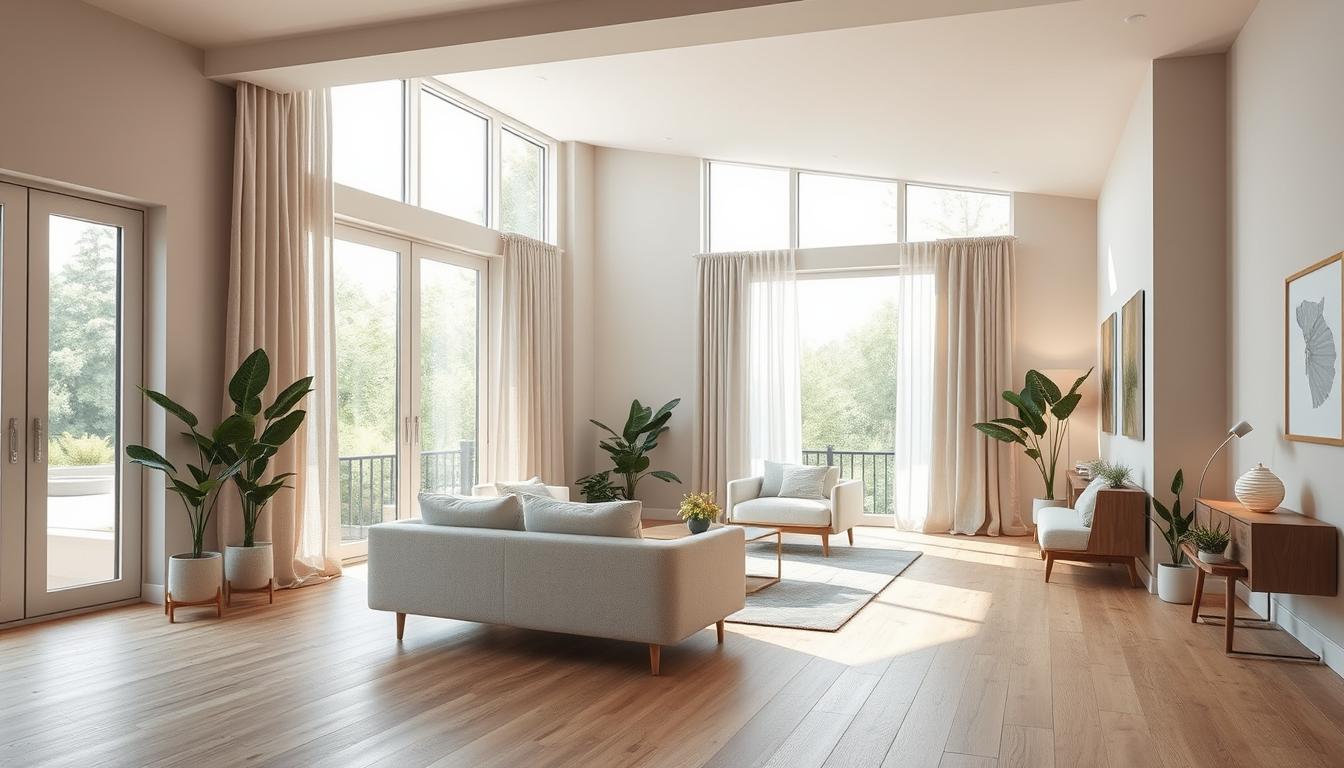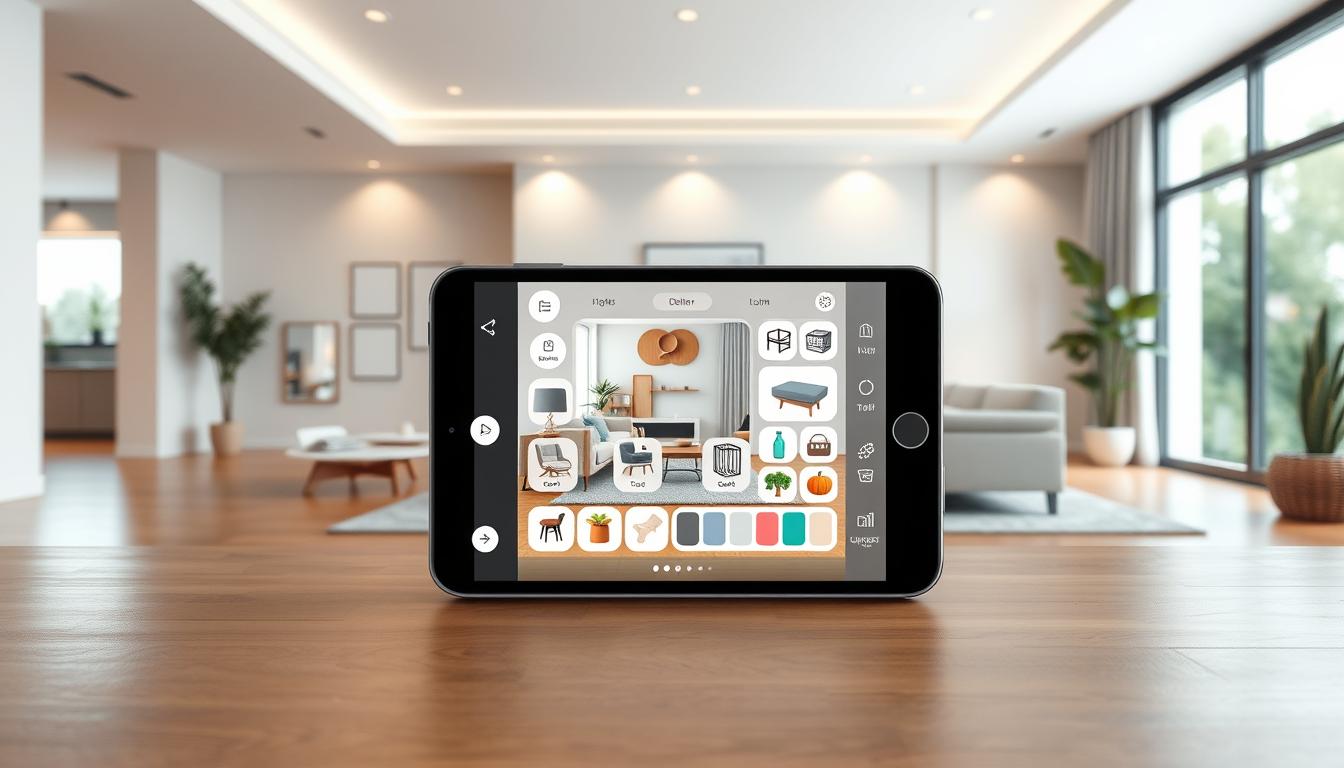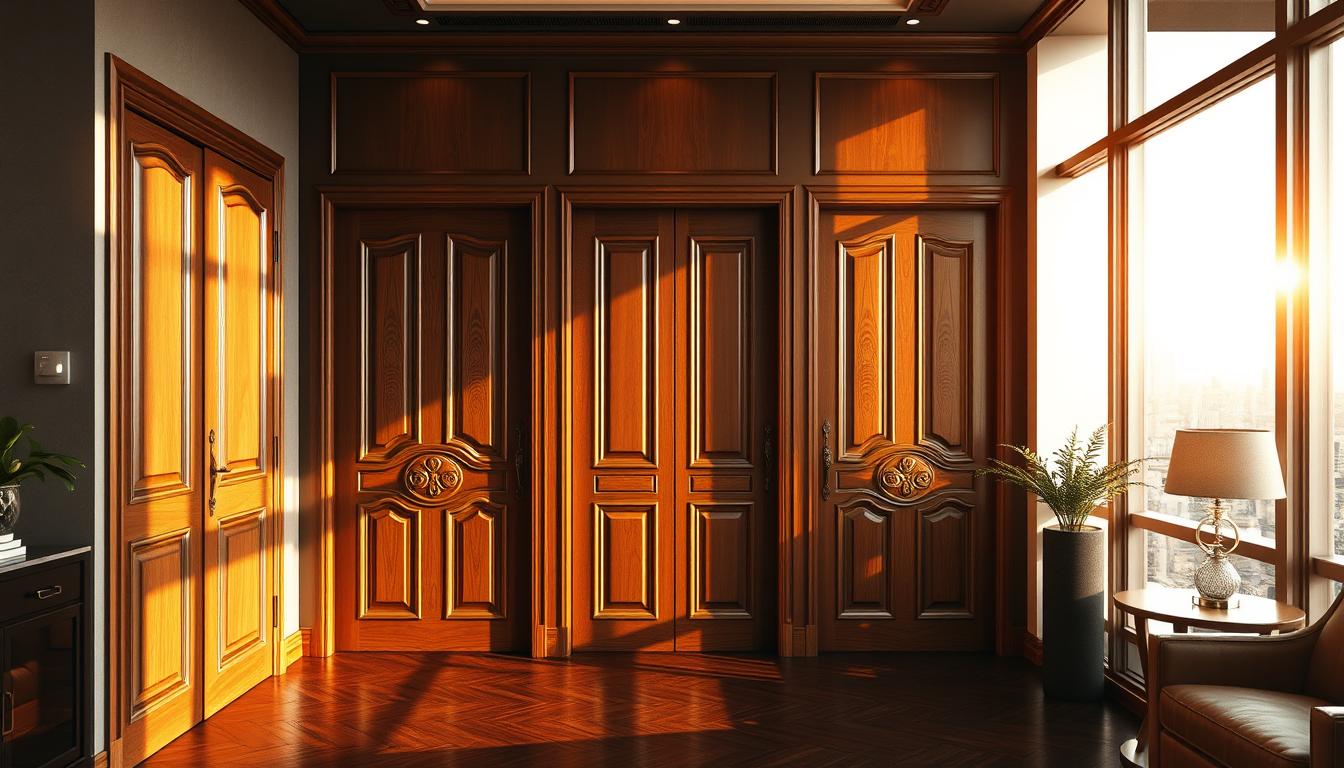Choosing the right colors for your living space can be daunting. With thousands of shades to choose from, it’s easy to feel overwhelmed.
We know picking the perfect paint colors is key. It can change how your home feels. In this article, we’ll help you find the best color palette for your style and space.
Key Takeaways
- Understanding the impact of color on your home’s ambiance
- Exploring different paint color options for various rooms
- Learning how to choose a color palette that suits your style
- Discovering tips for selecting the perfect home interior paint colors
- Getting inspiration from popular interior house paint colors trends
Understanding the Psychology of Color in Interior Design
When we design our homes, the colors we pick matter a lot. They can change how we feel and how well we work. Choosing colors is not just about looks; it’s about making a space that’s good for us.
How Colors Affect Mood and Emotions
Colors deeply affect our feelings and mood. Warm colors like oranges and reds make us talk more and feel lively. They’re great for places where we hang out, like living rooms and dining rooms.
Cool colors, like blues and greens, calm us down. They’re often used in bedrooms and bathrooms to help us relax.
How colors make us feel can be different for everyone. But, some colors are popular for their lasting appeal. Neutral colors are loved for being easy to match with. Bold colors add a special touch to any room.
Choosing Colors for Different Spaces
Choosing colors for each room depends on its purpose and the mood you want. For areas where we socialize, pick colors that encourage talking, like warm neutrals or bright colors. Bedrooms, on the other hand, need colors that help us relax.
If you want to keep up with trends, try trendy home paint colors. In 2023, earthy tones, soft pastels, and deep colors are in. They offer many choices for any taste.
The right colors can really change your home. They can make it show who you are and a place that’s good for your health. By knowing how colors work and what each room needs, you can pick colors that make your home better.
Popular Color Trends for Homes in 2023
As we enter 2023, interior design is buzzing with new color trends. These trends promise to change how we see our homes. This year, we’re seeing a wide range of colors that fit different tastes and styles. Let’s explore the top trends that are changing home interiors.
Bold and Dark Hues
Bold and dark colors are big in 2023. Deep blues, rich greens, and blacks are used to make homes cozy and intimate. These colors look great and make our homes feel warm and welcoming.
Benefits of Dark Hues:
- Create a cozy atmosphere
- Add depth to rooms
- Can be used as accent walls
Soft Pastels and Neutrals
Soft pastels and neutrals are also popular. These colors are calming and perfect for a peaceful home. They match many decor styles, from modern to traditional.
“Soft pastels bring a touch of softness and elegance to any room, making them perfect for bedrooms and living areas.”
Earthy Tones and Their Appeal
Earthy tones like brown, beige, and taupe are big in 2023. These colors add warmth and coziness to our homes. They make our homes feel welcoming and stylish.
| Color Trend | Description | Best Used In |
|---|---|---|
| Bold and Dark Hues | Deep, rich colors that create a cozy atmosphere | Living rooms, bedrooms |
| Soft Pastels and Neutrals | Soft, calming colors for a serene environment | Bedrooms, living areas |
| Earthy Tones | Natural colors for a warm, organic look | Any room, for a natural look |
In conclusion, 2023 is all about finding the right color trend for your home. Whether you like bold statements or soft colors, there’s something for everyone.
Best Practices for Choosing the Right Paint Color
Choosing the right paint color is more than just a personal choice. It’s about creating a welcoming atmosphere in your home. With so many options, it can be hard to decide. But, by following some best practices, you can make it easier and get the look you want.
Testing Samples Before Committing
Testing paint samples on your walls is a key step. As we suggest, “Try to pick a color in your space, and avoid picking a paint color at the store.” This way, you can see how the color looks in your home’s lighting and at different times.
To test samples effectively:
- Paint a small swatch on the wall
- Observe the color at different times of day
- Consider how the color looks under various lighting conditions
Considering Lighting and Space Size
Lighting and space size are key factors in how paint colors look in your home. Natural and artificial light, plus room size, affect the color’s appearance.
For smaller spaces: Lighter colors can make rooms seem bigger and more open.
For larger spaces: You can try both lighter and darker shades.
By thinking about these factors and testing samples, you can choose a color that makes your space beautiful and reflects your style.
Color Combinations That Work Wonders
Choosing the right colors for your home can make a big difference. The right mix of colors can change how your space feels. It’s all about how colors work together.
As Jonathan Adler, a famous designer, said,
“Color is a very powerful tool, and it’s very personal.”
This personal touch is key when picking colors.
Monochromatic Schemes
A monochromatic scheme uses different shades of one color. It creates a smooth, elegant look. It’s perfect for those who like a calm, sophisticated feel.
For example, using different blues can make a room feel peaceful. You can add depth by mixing textures and tones within the same color family.
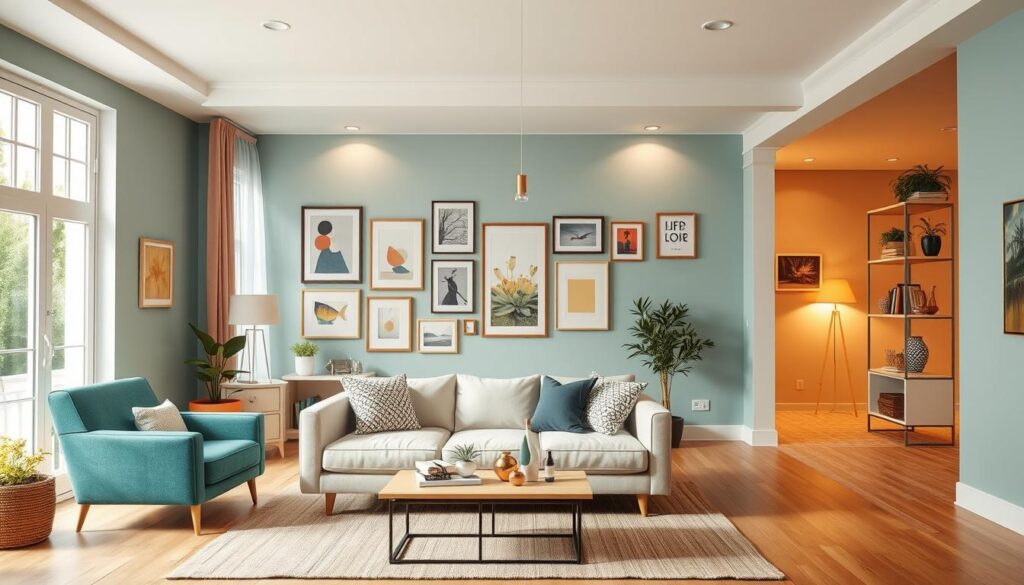
Complementary Color Palettes
Complementary colors are pairs that are opposite each other on the color wheel. They make a room lively and interesting. For instance, blue and orange or red and green can make a bold statement.
But, it’s important to balance these bold colors with neutral ones. This keeps the space looking good without feeling too much.
Accent Walls: Making a Statement
Accent walls are a great way to add a pop of color or texture. Painting one wall differently creates a focal point. It draws the eye to that area.
For a modern touch, pair a neutral background with a bold accent wall. This adds interest and depth to the room.
Exploring these color combinations can help you find the perfect match for your style. Whether it’s a monochromatic scheme, complementary colors, or an accent wall, the right colors can truly transform your space.
Room-Specific Color Suggestions
Choosing the right interior house paint colors can change how each room feels. Different rooms have different uses, and the paint color should match that. For social areas like dining rooms and kitchens, warm colors like yellow and red work well. In private spaces like bedrooms and bathrooms, cooler colors like blue and green are better.
Warm and Inviting Shades for Living Rooms
The living room is where we spend time with loved ones. Warm colors make it cozy and welcoming. Try earthy tones like terracotta or sienna for a cozy feel. For a modern look, deep blues or rich greens are great. See Benjamin Moore’s living room ideas for inspiration.
Soothing Colors for Restful Sleep in Bedrooms
Bedrooms are for rest and relaxation. Soft colors create a peaceful atmosphere. Pastels, neutrals, or calming blues are good choices. They help you relax and sleep well.
“The choice of color for your bedroom can significantly affect the quality of your sleep.”
Bright and Energizing Options for Kitchens
Kitchens are the heart of the home, where meals are made and memories are created. Bright colors make it lively and inviting. Whites, creams, and light grays are popular for a clean look. Adding a bold color on an accent wall can also brighten the space.
- Whites and creams for a clean look
- Light grays for a modern feel
- Bold colors for an accent wall
Calm and Refreshing Choices for Bathrooms
Bathrooms should be calming and refreshing. Soft blues, pale greens, or whites create a spa-like feel. These colors make the space feel clean and serene, perfect for starting or ending your day.
| Room | Recommended Colors | Effect |
|---|---|---|
| Living Room | Warm earthy tones, deep blues | Cozy and welcoming |
| Bedroom | Soft pastels, gentle neutrals | Peaceful and restful |
| Kitchen | Whites, creams, light grays | Bright and energizing |
| Bathroom | Soft blues, pale greens | Calm and refreshing |
Choosing the right interior house paint colors for each room can improve your home’s feel. Whether you want trendy colors or timeless classics, the right shade can make a big difference.
The Role of Finish in Paint Selection
Understanding paint finishes is key to the look of your home. The finish greatly affects how your interior spaces feel. It’s as important as choosing the color.
You can pick from gloss, matte, satin, and eggshell finishes. Each has its own benefits for different looks and surfaces.
Gloss vs. Matte: What to Choose
The choice between gloss and matte is a big one. Gloss finishes are shiny and durable. They’re great for trim, doors, and windows because they’re easy to clean and handle moisture well.
Matte finishes are flat and hide small imperfections. They’re perfect for ceilings and walls where you want a calm look.
| Finish Type | Sheen Level | Durability | Best Use |
|---|---|---|---|
| Gloss | High | High | Trim, doors, windows |
| Matte | Low | Medium | Ceilings, walls |
| Satin | Medium | High | Walls, trim |
| Eggshell | Low-Medium | Medium | Walls |
Benefits of Satin and Eggshell Finishes
Satin finishes are a mix of gloss and matte. They’re durable and easy to clean. They’re perfect for busy areas.
Eggshell finishes are a bit shinier than matte but still soft. They add warmth and are durable. They’re great for living rooms and bedrooms.
“The right paint finish can elevate the ambiance of a room, making it feel more welcoming and sophisticated.”
Think about each room’s needs when picking a finish. Lighting, traffic, and style matter. The right finish makes your paint job look better and last longer. It adds to your home’s appeal.
Sustainable and Eco-Friendly Paint Options
The modern interior color palette is more than looks; it’s about being green. We’re all getting more eco-friendly, and that includes paint. This change is key to lessening our impact on the planet.
When picking paint, we often forget about VOCs and air quality. VOCs are chemicals that can harm us. Knowing about VOCs helps us choose better paint.
Understanding VOCs and Their Impact
VOCs are bad for our health and the environment. Paints with lots of VOCs can pollute our homes. Low-VOC or VOC-free paints are better for us and the planet.
When looking for eco-friendly paint, check for Greenguard Gold or CARB Compliant labels. These show the paint is safe for indoor air. Choosing these paints makes our homes healthier and helps the planet.
Brands Leading the Eco-Friendly Movement
Many brands are leading the way in eco-friendly paint. Benjamin Moore, Behr, and Farrow & Ball offer paints that are good for us and the earth. They focus on making paint that’s healthy and sustainable.
Benjamin Moore’s Natura line has zero VOCs and lots of colors. Behr’s Premium Plus ULTRA line is low-VOC and lasts long. These options help us choose paint that’s good for our homes and the planet.
As we update our home colors, using eco-friendly paints is a smart move. By picking the right brands and understanding VOCs, we can make our homes beautiful, safe, and green.
How to DIY Your Interior Painting Project
Starting a DIY interior painting project might seem tough, but it’s actually easy. Painting your home’s interior can refresh your decor and make your space feel welcoming. It’s a chance to make your creative home paint ideas real.
Essential Tools and Equipment
Before you begin, gather the right tools and equipment. You’ll need:
- High-quality paint that matches your color and finish
- Paintbrushes in different sizes
- Roller extension poles
- Paint trays
- Drop cloths or tarps
- Masking tape for sharp edges
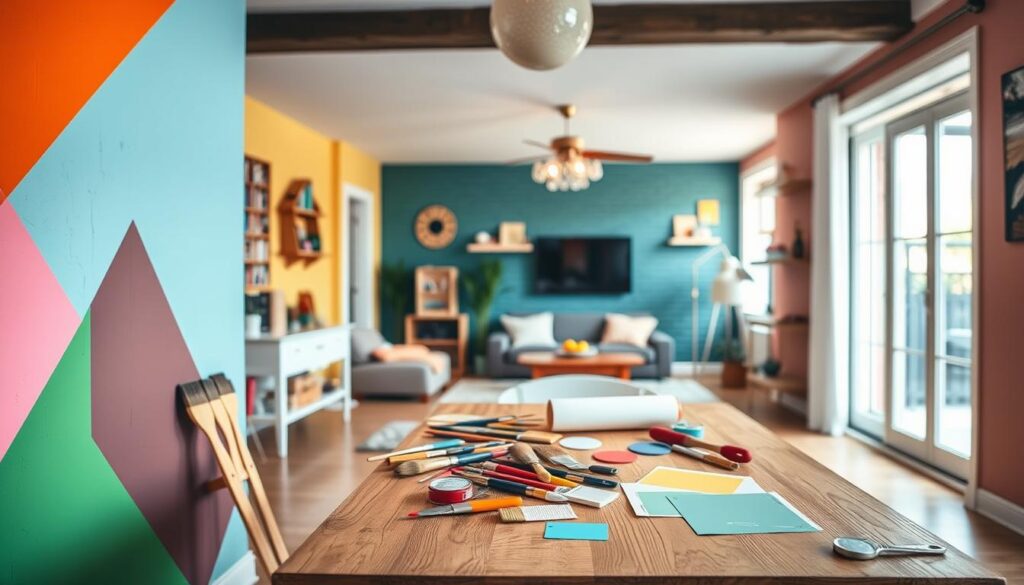
Step-by-Step Guide to Painting Walls
Here’s a simple guide to get professional results:
- Prepare the Area: Move furniture out and cover the floor and any furniture left with drop cloths.
- Clean the Walls: Wipe off dirt, grime, and grease for better paint adhesion.
- Tape Off Edges: Use masking tape to protect trim, baseboards, and areas you don’t want to paint.
- Prime if Necessary: Apply a primer if you’re using a dark color or covering a light color.
- Paint: Start painting from the top of the wall and work down, using a ‘W’ or ‘M’ pattern with your roller for even coverage.
- Apply Additional Coats: Let the first coat dry, then add more coats as needed.
- Remove Tape: Remove the masking tape carefully to avoid pulling off the paint.
By following these steps, you can get a beautiful, professional-looking finish. It will bring your creative home paint ideas to life.
Hiring a Professional vs. DIY Painting
When looking at interior wall paint inspiration, you might think about whether to hire a pro or do it yourself. The choice between a professional painter and DIY painting depends on several things. These include the job’s complexity, your budget, and what you prefer.
Benefits of Professional Help
Choosing a professional painter comes with many advantages. They have the expertise and experience for a top-notch finish. They also help with picking colors and paints. Plus, they have the right tools and team to get the job done fast.
- Expertise in color matching and paint selection
- Access to high-quality equipment and materials
- Efficient completion of the project
| Aspect | Professional Painter | DIY Painting |
|---|---|---|
| Expertise | High | Variable |
| Time Required | Less | More |
| Cost | Higher upfront cost | Lower upfront cost |
When to Consider DIY Approaches
While pros are usually the best choice, DIY painting works in some cases. If your project is small and simple, or if you’re watching your budget, DIY can save money. It’s also a fun way to get creative.
Consider DIY painting if:
- You have a small area to paint
- You are comfortable with the physical demands of painting
- You are looking to save money on labor costs
In conclusion, whether to hire a pro or do it yourself depends on your situation. Weighing the pros and cons of each option helps you choose what’s best for your project.
Maintaining Your Painted Walls and Colors
To keep your home looking its best, maintaining your painted walls is crucial. With the right home interior paint color ideas, you’ve set the stage for a beautiful living space. Now, let’s explore how to preserve that fresh look.
Long-Lasting Finish Tips
Regular cleaning is essential to prevent dirt buildup. Use a soft cloth and mild soap to gently wipe down walls. For best home paint colors that are prone to fading, consider applying a UV-resistant clear coat to protect the paint.
Repairing Scratches and Marks
Minor scratches and marks can be easily repaired with a touch-up paint. Ensure you have some leftover paint from your original painting project. For more significant damage, consider consulting a professional for a seamless repair.
By following these simple maintenance tips, you can enjoy your chosen home interior paint color ideas for years to come. Whether you’ve opted for bold hues or soothing neutrals, a little care goes a long way in preserving the beauty of your home’s best paint colors.

